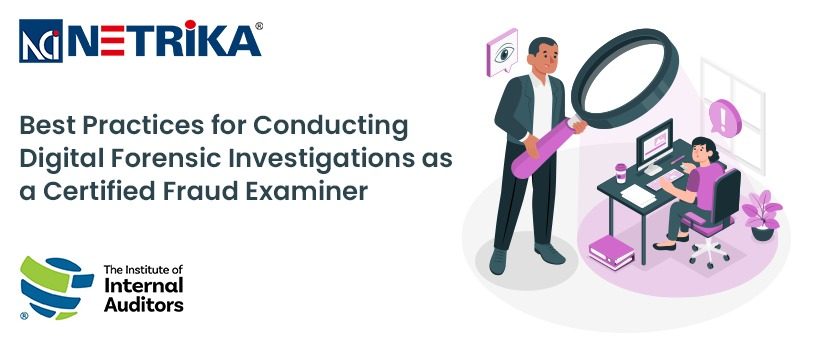News & Events
Netrika Training and Certifications | Security Training Company > Blogs > Best Practices for Conducting Digital Forensic Investigations as a Certified Fraud Examiner
Best Practices for Conducting Digital Forensic Investigations as a Certified Fraud Examiner
- July 10, 2024
- Posted by: marketing@netrika.com
- Category: Blogs
No Comments

Digital Forensic Investigations as a Certified Fraud Examiner
Digital forensic investigations are important in unveiling fraud, misbehavior, and hacking instances. To be an effective Certified Fraud Examiner (CFE), one needs to have competence in digital forensics investigation practices that include identification, preservation, analysis, and presentation of electronic evidence.
In this blog, we will look at the primary steps and strategies for conducting digital forensic investigations with the highest standards of truthfulness and correctness.
Best Practices for Conducting Digital Forensic Investigations as a CFE
- Grasping the Probe’s Extent: Before launching into digital forensic examination, it is important to clearly set out the scope and objectives of this examination. This entails specifying the particular allegations or suspicions of fraud, establishing what types of digital evidence might be pertinent, and appreciating regulatory legal requirements bearing on an investigation.
- Securing the Crime Scene: Just as it is crucial to maintain the integrity of traditional crime scenes, it is vital in digital forensics investigations as well. This requires that all relevant digital devices like computers, mobile phones, servers, and storage media are secured and isolated to avoid tampering with or altering evidence. During the process of investigating, appropriate chain of custody procedures have to be adhered to so as to keep up with its originality.
- Collecting and Preserving Digital Evidence: The next step after securing the crime scene is collecting and preserving digital evidence in a forensically sound manner. This may entail creating forensic images using specialized tools and techniques for acquiring a bit-stream copy of data without modifying original evidence. It is crucial that the digital evidence collection process is meticulously documented and maintained to ensure the admissibility of evidence in court.
- Analyzing Digital Evidence: In the analysis stage of a digital forensic investigation, the collected evidence is examined for relevant information and patterns that may either prove or disprove fraud allegations. This could entail retrieving deleted files, scrutinizing web browsing history, looking into email correspondences, and following up on e-transactions. Advanced forensic tools and techniques like keyword searching, data carving, and metadata analysis are used to reveal hidden pieces of evidence.
- Documenting and Reporting Findings: A digital forensic investigation ends with an all-inclusive report that has been properly documented. The report must give an extensive summary of the process involved in the study such as its range, ways of doing it, what was found out, and what can be inferred from them. It ought to present the evidence in a way that is easy to understand with cross-references to back-up documents and examination results. In addition, it has to follow legal ethics as well as professional guidelines since it will be prepared under the expectation of being involved in lawsuits or regulatory reviews.
- Maintaining Professionalism and Ethical Standards: Certified Fraud Examiners should observe professionalism, integrity, and ethical behavior at all stages of digital forensic investigations. They are expected to respect individual’s privacy rights by ensuring confidentiality on confidential matters concerning people while avoiding conflicting interests. Without any bias or preconceived notions, CFEs can ensure the integrity and credibility of the investigation findings.
A certified fraud examiner who conduits digital forensic investigation combines the technical expertise and investigative skills to effectively uncover fraudulent incidents and drive organizations to prevent financial loss and reputational damage.

